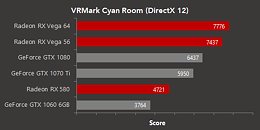Raevenlord
News Editor
- Joined
- Aug 12, 2016
- Messages
- 3,755 (1.16/day)
- Location
- Portugal
| System Name | The Ryzening |
|---|---|
| Processor | AMD Ryzen 9 5900X |
| Motherboard | MSI X570 MAG TOMAHAWK |
| Cooling | Lian Li Galahad 360mm AIO |
| Memory | 32 GB G.Skill Trident Z F4-3733 (4x 8 GB) |
| Video Card(s) | Gigabyte RTX 3070 Ti |
| Storage | Boot: Transcend MTE220S 2TB, Kintson A2000 1TB, Seagate Firewolf Pro 14 TB |
| Display(s) | Acer Nitro VG270UP (1440p 144 Hz IPS) |
| Case | Lian Li O11DX Dynamic White |
| Audio Device(s) | iFi Audio Zen DAC |
| Power Supply | Seasonic Focus+ 750 W |
| Mouse | Cooler Master Masterkeys Lite L |
| Keyboard | Cooler Master Masterkeys Lite L |
| Software | Windows 10 x64 |
Benchmarking company Futuremark has recently introduced a new benchmark to its VRMark suite, the Cyan Room, which brings the latest in rendering technologies to the VR world. Futuremark expects this test to leverage the latest hardware and software developments in DX12 to better utilize today's GPUs still somewhat untapped power. In something of a plot twist, AMD's Radeon architectures (in the form of Polaris 20-based RX 580 and Vega-based RX Vega 56 and RX Vega 64) trump NVIDIA's equivalent offerings in pure performance numbers.
Testing was performed by pairing a Ryzen 7 1800X CPU with a selection of graphics cards from both AMD and NVIDIA, supported by 16GB of DDR4-2933 system memory, and Windows 10 x64. In a post on Radeon gaming, Scott Wasson said that "The Cyan Room (...) highlights AMD's continued performance leadership on this (VR) front," adding that "the Radeon GPUs we tested have clear leads over their direct competition. What's more, all the Radeon GPUs are meeting the key requirement for today's VR headsets by delivering at least 90 frames per second in this test."



Which is true, hands-down: it's just a matter of looking at those AMD internal test numbers, where the RX Vega 56, which usually trades blows with the GTX 1070 Ti, is seen far ahead of NVIDIA's GTX 1080 graphics cards. An equally impressive showing is delivered by AMD's RX 580, which leads its NVIDIA competitor, the GTX 1060 6 GB, by a wide as margin as the Vega-based cards. This is impressive, to say the least, and a far-cry from what we're used to seeing from the AMD camp this generation, at least when it comes to pure frame rate competitiveness.

View at TechPowerUp Main Site
Testing was performed by pairing a Ryzen 7 1800X CPU with a selection of graphics cards from both AMD and NVIDIA, supported by 16GB of DDR4-2933 system memory, and Windows 10 x64. In a post on Radeon gaming, Scott Wasson said that "The Cyan Room (...) highlights AMD's continued performance leadership on this (VR) front," adding that "the Radeon GPUs we tested have clear leads over their direct competition. What's more, all the Radeon GPUs are meeting the key requirement for today's VR headsets by delivering at least 90 frames per second in this test."



Which is true, hands-down: it's just a matter of looking at those AMD internal test numbers, where the RX Vega 56, which usually trades blows with the GTX 1070 Ti, is seen far ahead of NVIDIA's GTX 1080 graphics cards. An equally impressive showing is delivered by AMD's RX 580, which leads its NVIDIA competitor, the GTX 1060 6 GB, by a wide as margin as the Vega-based cards. This is impressive, to say the least, and a far-cry from what we're used to seeing from the AMD camp this generation, at least when it comes to pure frame rate competitiveness.

View at TechPowerUp Main Site
Last edited by a moderator:




